
 Costa Crociere today operate a fleet of a dozen huge cruise ships with a passenger capacity ranging from 2,200 to 3,780, and with even bigger ships on order. Costa Atlantica, Costa Diadema, Costa Deliziosa, Costa Fascinosa, Costa Favolosa, Costa Fortuna, Costa Luminosa, Costa Magica, Costa Mediterranea, Costa Pacifica, Costa Serena, and Costa Victoria are purpose built cruise ships with very stylish public rooms and Italian decor. The company was founded by three Costa brothers, Enrico, Eugenio and Federico – in the early 20th century in the busy port of Genoa, and was operating emigrant ships in the 1950s until the first cruise ship, the veteran Franca C dating from 1914, began the first cruise from Fort Lauderdale to the Caribbean in 1959. Converted liners made up the fleet throughout the 1980s, when it was the second largest cruise line in the world, second only to the Soviets. The takeover by Carnival Cruise Line in 1997 propelled into higher echelon of cruise lines, with giant cruise ships built to classes determined by Carnival Cruise Corporation for operation by themselves or their many subsidiaries.
Costa Crociere today operate a fleet of a dozen huge cruise ships with a passenger capacity ranging from 2,200 to 3,780, and with even bigger ships on order. Costa Atlantica, Costa Diadema, Costa Deliziosa, Costa Fascinosa, Costa Favolosa, Costa Fortuna, Costa Luminosa, Costa Magica, Costa Mediterranea, Costa Pacifica, Costa Serena, and Costa Victoria are purpose built cruise ships with very stylish public rooms and Italian decor. The company was founded by three Costa brothers, Enrico, Eugenio and Federico – in the early 20th century in the busy port of Genoa, and was operating emigrant ships in the 1950s until the first cruise ship, the veteran Franca C dating from 1914, began the first cruise from Fort Lauderdale to the Caribbean in 1959. Converted liners made up the fleet throughout the 1980s, when it was the second largest cruise line in the world, second only to the Soviets. The takeover by Carnival Cruise Line in 1997 propelled into higher echelon of cruise lines, with giant cruise ships built to classes determined by Carnival Cruise Corporation for operation by themselves or their many subsidiaries.
Costa Marina and Costa Allegra were very stylish near sister Italian cruise ships for twenty years, that had started their careers as Swedish container ships for Johnson Line, and were then converted with much Italian flair by the T. Mariotti yard in Genoa with Martinoli & Compania srl as conversion consultants. The interior designer Guido Canali was handed the job of internal design and decoration, and produced a very handsome, if boxy, pair of cruise ships that were nicknamed ‘The Ships of Glass’. The container ship hulls were completely gutted, and the Genoese shipyard workers started again from scratch, building eight new passenger decks using hundreds of tonnes of steel, and, in the case of Costa Allegra, inserting a new forty four feet long ‘midships section weighing eight hundred tonnes. The view from astern was of a cutaway stern with a three deck high wall of thick ‘plexiglass’ used as observation areas, behind which the handsome public rooms were fashioned, with large areas of glass of over 8,000 square metres for walls and dividing spaces to give as much natural lighting as possible in the public rooms. Hence the nickname ‘The Ships of Glass’.
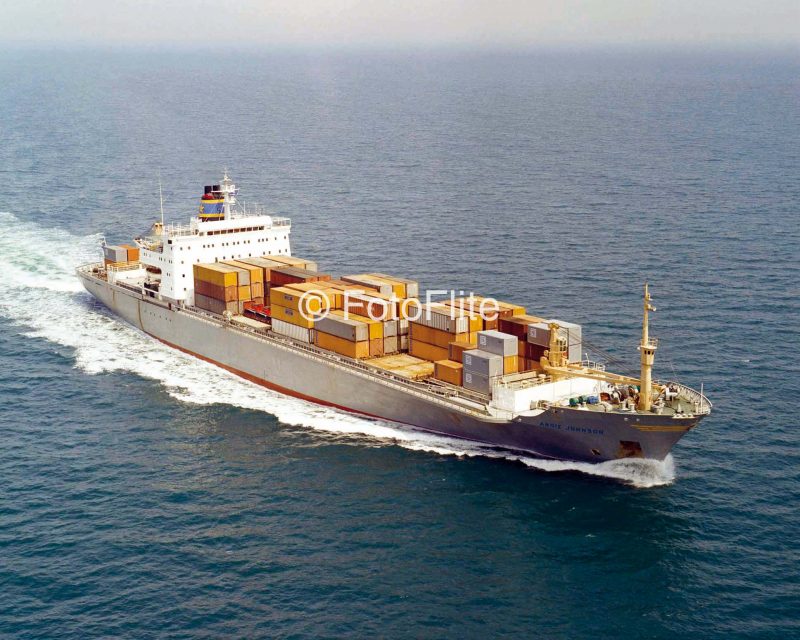
Costa Allegra was much the better of the pair with a much higher standard of finish to her staterooms and public rooms, having benefitted from the problems of conversion that were solved on Costa Marina. A three deck glass lobby and atrium greeted her passengers on the lowest deck named Lautrec Deck, with six more famous names of artists used for the decks above in Gauguin Deck, Van Gogh Deck, Modigliani Deck, Degas Deck, Rousseau Deck, and Manet Deck. Solarium Deck at the top had raised open walkways above gorgeous swimming pools, sunning areas, and quiet spaces where one could get away from the crowds on the main public room decks below. Glass skylights, domes, walls, and dividing spaces gave glass from ‘floor to ceiling’, with white as the main decorative colour throughout the ships. The group of five tall ‘stove pipe’ funnels, three of them painted yellow and two painted white, again gave the ships an unique look.
Conversion From Container Ships
The pair belonged to a standard class of five container ships that were constructed by the Wartsila yard at Turku in Finland as Axel Johnson of 1969, Annie Johnson of 1969, Margaret Johnson of 1970, San Francisco of 1970, and Antonia Johnson of 1971. Johnson Line had started in business in 1890 led by Axel Axelson Johnson, with services from Sweden to Brazil, the Plate, Colombia and later through the Panama Canal to North West ports in the U.S.A. and Canada. Some 130 ships were owned in one hundred years of operation to 1990, with a class of Johnson cargo-liners completed in 1947 as the fastest ships of their type in the world with a service speed of 19 knots and ‘flat out’ speeds of twenty knots.
The five sister container ships were used on the Johnson Scanstar consortium service to British Columbia and North West American ports. The dimensions of the quintet were length of 571.5 feet, moulded beam of 84.5 feet, and draft of 34.1 feet with a service speed of 23 knots from twin twelve cylinder and twin sixteen cylinder Wartsila-Pielstick diesels of 26,140 bhp, coupled in pairs, and driving twin controllable pitch propellers. They had a gross tonnage of 16,289, deadweight of 16,080 with 744 TEU of containers in seven cellular holds served by 28 hatches, and carried a dozen passengers in luxurious cabins with excellent views over the cargo operations using two large gantry cranes of 25 and 35 tonne capacity to lift twenty and forty feet containers on and off at ports with no shore facilities. The two gantry cranes were removed at a later date, and placed in storage at Gothenburg while Johnson Line tried to find a buyer for them. A crew of thirty was carried on their long voyages, and they were made redundant in 1986 after the absorption of Johnson Line into Silja Line. Ferry services were the preferred way forward with the quintet replaced by two chartered larger container ships, and later leased slots on Evergreen Line.
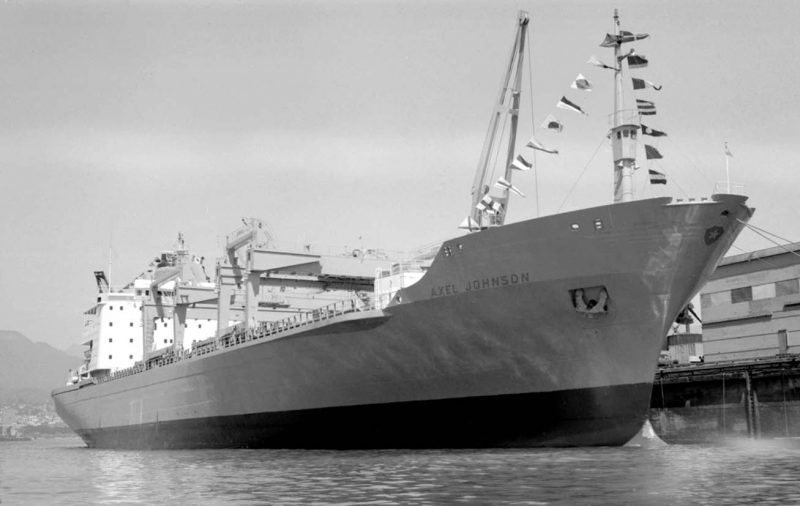
Axel Johnson, Annie Johnson and Margaret Johnson were sold for $1.23 million each to Antonis Lelakis of Greece to transform them into cruise ships in the same manner that Karras of Greece had done to the former Port Line cargo-liners Daphne and Danae. The trio were given ‘Regent’ prefixes to their new names, but two were sold on to Mediterranean Shipping Company (MSC), with Regent Moon ex Annie Johnson in service as the MSC container ship Alexandra between 1988 and 1990. Regent Sun ex Axel Johnson was laid up and then was sold in 1987 to Italian Bruno Quiriconi and his Navyclub srl company to begin the conversion under the name of Italia. No further progress was made until the ship was sold to a Costa Line company, and new blueprints were finally drawn up for the conversion that began in September 1988.
The conversion followed the general arrangement of cruise ships, with the purser, shore excursions, and bookings on the lower deck with a central atrium, which extended up several decks and was the principal embarkation area. Upper decks were devoted to sun decks, sports activities, observation decks and lounges, spas, fitness centres, and a lido with swimming pools, cafeterias and verandah restaurants. More decks were devoted to sophisticated public rooms, casinos, theatres, lounges, discos, cinemas, libraries, shops and a variety of international cuisine restaurants. Two years later and many millions of man hours of work, a ‘butterfly’ had morphed from the container ship pupa, and the ship sailed for her power trials on 9th June 1990. She was christened as Costa Marina five days later by Ersilia Bracaloni, the wife of a director.
Large construction subsidies from the Italian Government were forthcoming for the two conversions, but the work had not been without many problems. Costa Marina now measured 25,441 grt with a net tonnage of 10,790, and her length was now 176.21 metres and a moulded beam of 25.75 metres. The original engines were retained after a thorough overhaul but new thrusters, variable pitch propellers, new auxiliary generators, and stabilisers were fitted. However, by far the biggest changes were her staterooms and public rooms crafted by the overwhelming use of glass, with white and pink touches for bathrooms, and white and glass panels in all of her many public rooms. The staterooms were extremely modern in design, with low cupboards and sofas with no supports at their ends, modern Italian coffee machines, lighting, disposal bins, television and sound systems, and wall to wall art of a type that was of an acquired taste.
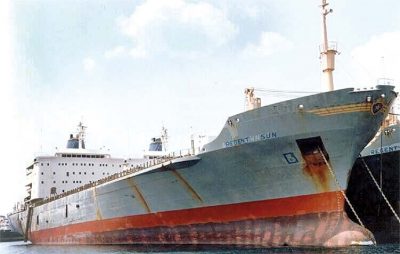
Costa Marina sailed from Genoa on her maiden summer cruises in the Mediterranean, the Canary Islands, and switched to the Caribbean for her winter programme. Now that she was successfully in service, the conversion of Costa Allegra (ex Annie Johnson, Regent Moon and Alexandra) began after her purchase from MSC by Costa Line. The cost of these two conversions was very high at a combined $310 million, as thick floor to ceiling glass panels do not come cheap, and was the reason why the third of the Johnson Line vessels sold to Lelakis, Margaret Johnson, had been sold for breaking up. The lengthening of Costa Allegra by forty four feet was in response to providing more cabins to help her profitability to 810 passengers based on occupancy of two to a cabin, compared to 772 passengers based on the same occupancy for Costa Marina. Costa Crociere acquired Costa Allegra on 28th August 1990, and the workforce of the Mariotti yard started their complex conversion a few days later, and re-engined her with four new Wartsila four stroke six cylinder diesels of 26,104 bhp to give a cruising speed of 20.5 knots. The workforce completed the job in November 1992, and Costa Allegra sailed on her maiden cruise on 23rd November 1992 with a Transatlantic cruise from Genoa to St. Thomas in the Caribbean, and followed the same pattern of northern summer cruises and Caribbean winter cruises as her near sister.
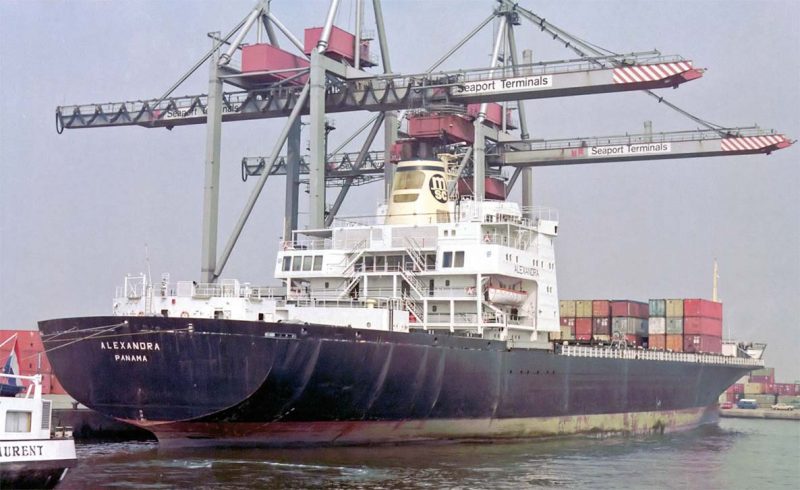
Costa Allegra Public Rooms
Costa Marina and Costa Allegra were very certainly ‘fun’ cruise ships and just what the market of a younger generation of cruise passengers needed. Costa Allegra was much the better cruise ship of the two, and will be described in more detail than her near sister. She differed from her sister in small identification features e.g. she had three large portholes under her bridge wings whereas Costa Marina had large porthole windows under her bridge but only two under the bridge wings. Costa Allegra had her radar domes clustered together, and had an extra tender on each side of her hull. She had 405 staterooms (218 outside, 187 inside) including thirteen suites of which ten had a full balcony. She had six bars, three restaurants, four elevators, two swimming pools with a further paddling pool for children, several Jacuzzis, the Caracalla fitness and spa centre, an outdoor jogging track, a theatre, casino and a discotheque. Costa Allegra had a higher gross tonnage of 28,430 with a length of 187.7 metres (616.1 feet), moulded beam of 25.8 metres (83.9 feet), a draft of 8.2 metres (26.9 feet) and a crew of 420. She had a cruising speed of twenty knots from her four new Wartsila diesel engines and twin propellers. All of her Dining Room staff stewards were Italian, and meals were served in two sittings in the grand Montmartre Restaurant on Modigliani Deck. The eight decks are now described, working upwards.
LAUTREC DECK This was the embarkation deck with a spacious three deck high lobby complete with Tour Office and Information Desk. Elevators were opposite the stair tower, and the forward corridors led to staterooms, the ship’s chapel and public areas with large colourful murals. All of the atriums on the ship had art installations, the one on this deck had a circular base with an open top a few feet in height, in which thin fluted glass vertical columns stretched through the three decks above.
VAN GOGH and GAUGUIN DECKS Outside (156 square feet) and inside staterooms (146 square feet) filled both of these decks.
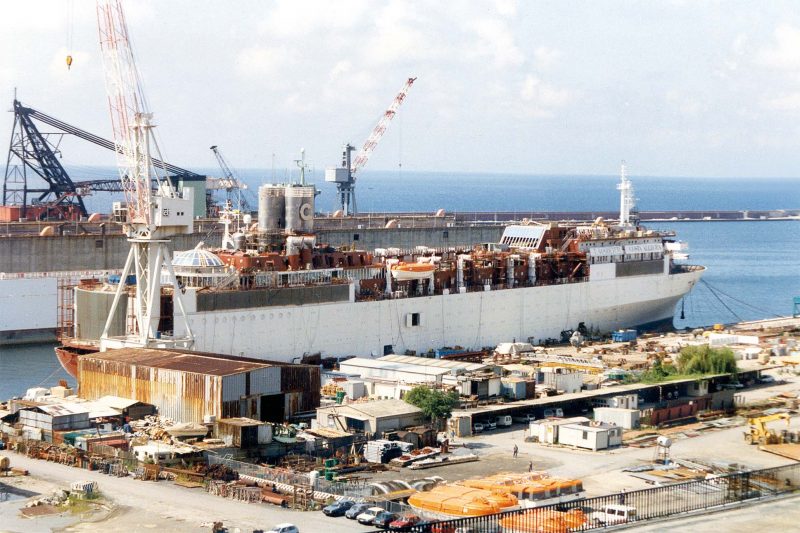

MODIGLIANI DECK had a main feature of the Montmartre Restaurant seating 474 people. The large porthole windows were a feature, and the rectangular and round tables with purple fabric chairs or backrests were set for four, six or eight people. The entrance to the restaurant featured large green and yellow wall murals as well as restrained light brown wooden panel decor. A Baby Grand piano provided background music to the served meals, with mirrors used to create the impression of a larger internal space. Carved wall panelling of Italian Carrrara marble gave a very elegant look to this big room.
DEGAS DECK The aft section of this deck featured the Flamenco Ballroom with seats for 220 people. The aft wall of thick ‘plexiglass’ admitted light, with an art installation in silver and wood positioned in the middle. A lobby forward of the ballroom had wall art murals, and moving forward again one reached the Monte Carlo Casino with 170 seats and every conceivable card game or machine. There was also a space overlooking the main lobby down on Lautrec Deck with galleries of photographs to port and starboard. Near the forward end of the casino was the large square glass topped Murano Bar with 125 seats, featuring royal blue Venetian glass installations, to entertain passengers sitting in comfortable blue or red armchairs or on red bar stools. The Card Room and Library were to port and starboard of the Murano Bar, and close to the forward stair well was the Piazzetta Allegra, a large circular room with several small shops, a Baby Grand piano, and a bar arranged around the outside, and a decorated modern style circular ceiling. The large Folies Bergeres Theatre with 370 seats completed the extreme forward end of the deck as the main entertainment centre, decorated in red and seating passengers on tiered comfortable brown padded seating facing aft towards the central stage.
ROUSSEAU DECK had several Grand Suites for upgraded passengers, plus ten Mini Suites and ten large inside staterooms at the forward end. The main room was the stylish Yacht Club Buffet seating 180 passengers with half models of famous yachts on the walls, wooden floors, large glass window panels, cane furniture, and shaded outside terraces for the perfect lunch. This in turn opened out onto the Crystal Club Disco with 110 seats, and had a very large glass dome above and attached to the rear of the funnels to admit more light to the dancers below. The dance floor had a mixture of yellow, red, blue and grey geometric shapes, surrounded by very comfortable armchairs in blue and red and bar stools in red to retire to after dancing.
MANET DECK had an airy large conservatory of a room called the Caracalla Spa at the forward end, with running and exercise machines interspersed with tall potted plants. The outdoor part of the deck was extensive and featured a large pool and jacuzzis all the way from abaft the navigating bridge area to her trademark yellow ‘stove pipe’ funnels. The amount of open deck space was extensive with a large stock of sun loungers.
SOLARIUM DECK at the top had raised open walkways above gorgeous swimming pools, sunning areas, and quiet spaces in the forward area of the superstructure and aft around the Crystal Club disco and funnel area, where one could sunbathe or quietly read, away from the hurly-burly of the crowds on the main four public room decks below on Modigliani Deck, Degas Deck, Rousseau Deck and Manet Deck.
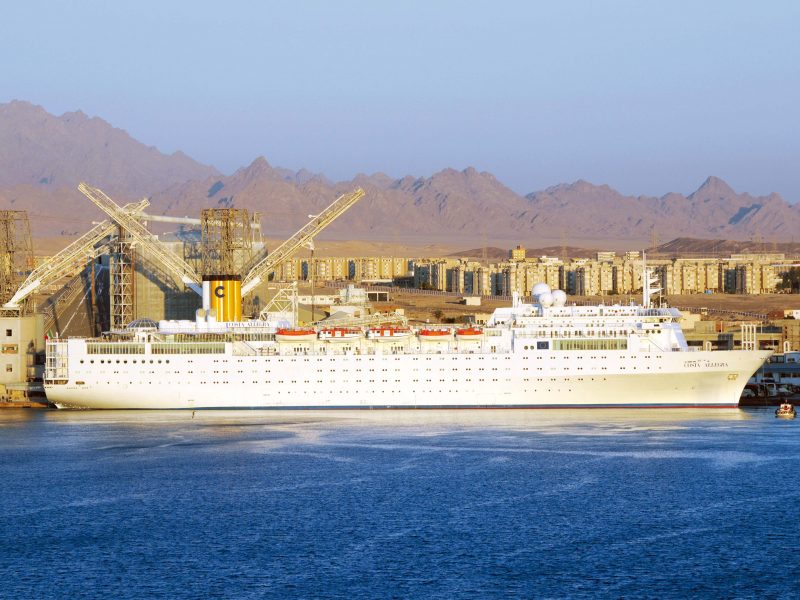
The Near Sisters Cruise Service
The home port of departure of stylish Costa Line cruises also received a facelift when the two new cruise ships entered service, to mark the 500th anniversary of the discovery of the New World by Genoa born Christopher Columbus in 1992. This included a new Cruise Terminal, an upgraded Stazione Marittima ferry terminal, and a facelift for the Porto Antico area of the port. The latter featured a cluster of cranes known as the ‘Bigo’ panoramic lift offering a 360 degree view of the port. ‘Bigo’ was designed by architect Renzo Piano to offer an aerial view of the port with an audio system to give an historical commentary of the ancient port area of Genoa. Costa Crociere vessels that could be seen in port in 1992/93 included Costa Marina, Costa Allegra, Eugenio Costa, Daphne, Danae, Enrico Costa and Costa Riviera, the former Lloyd Triestino liner Guglielmo Marconi of 1963, which now cruised permanently in the Mediterranean.
Summer Mediterranean cruising from Genoa and Caribbean winter cruises from Miami and Fort Lauderdale by Costa Marina and Costa Allegra were replaced with the entry into service of the much larger Costa Classica and Costa Romantica in 1993. Costa Marina was transferred to South American cruises from Buenos Aires, and Costa Allegra transferred to Eastern Mediterranean cruises from Venice or Genoa on ten day cruises in the summer of 1993. Costa Allegra was based at Amsterdam in the summer of 1994, cruising to the Baltic and North Cape and the Norwegian fjords, and she was joined by her near sister on these routes in the summers of 1994 and 1995.
Costa Crociere had a fleet of seven modern cruise ships in 1996, with three new ones and four conversions, and Costa Marina made a total of six seven night cruises from Copenhagen to Flam, Vik, Hellesylt, Geiranger, Bergen, Stavanger and Oslo in the summers of 1996 and 1997. At the end of this summer programme, she cruised from Copenhagen back to Genoa with calls at Dover, St. Malo, Vigo, Lisbon, Cadiz, Malaga and Palma de Mallorca. Costa Allegra made a nine night cruise from Genoa to Amsterdam at the end of April in 1996, and again in April 1997, to cruise during the summer to the same Baltic and Norwegian destinations as her sister, but from Amsterdam. Costa Allegra then made four seven night cruises from Genoa in the Western Mediterranean during September and October 1997 to Palma de Mallorca, Lisbon, Cadiz and Malaga, before moving across the Atlantic for winter Caribbean cruising from Fort Lauderdale.

The takeover of Costa Crociere by Carnival Cruises of Miami in early 1998 began the ordering of a long series of identical sister ships of 82,000 grt or bigger for Carnival Cruises and for the subsidiaries of Costa Crociere, Holland America Line, and later for P. & O. Cruises and Cunard Line. Costa Marina and Costa Allegra were much smaller cruise ships compared to these giants, and were then based for the traditional South American cruise market in Rio de Janeiro, Santos and Buenos Aires instead of Caribbean cruises. Costa Allegra was forced to cut short her South American programme by six months in 2002 due to Argentinean financial problems, and she returned to Genoa. The pair continued their summer cruising seasons with seven night cruises from Amsterdam and Copenhagen. Costa Marina made some seven night Western Mediterranean cruises in late Autumn of Millenium year before cruising from South America, while near sister Costa Allegra was engaged on seven night Eastern Mediterranean cruises to Piraeus, Rhodes, Limassol and Alexandria before also cruising from South America.
The pattern of northern capitals, Baltic and North Cape cruises in summer from Amsterdam (Costa Allegra) and Copenhagen (Costa Marina), and then transfer to the South American market was repeated during the next five years to 2005. After a $12 million refurbishment at the Mariotti yard, Costa Allegra was relocated to cruising out of China in June 2006, with her interiors completely refurbished to better suit the Chinese taste. She cruised on five night cruises from Shanghai to Nagasaki in Japan, and Cheju in South Korea, with longer cruises to the Philippines, Malaysia, Viet Nam, Thailand and around the Indonesian islands. Costa Classica and Costa Romantica replaced her on these Far Eastern cruises in 2010, and Costa Allegra was transferred back to the Mediterranean to cruise in the French market from Marseille for Paquet Cruises, which had obtained a 23% shareholding in Costa Crociere at the end of 1992. She was marketed as Allegra although her name did not change, and she made four Spring cruises and seven Autumn cruises from Marseille in 2010. She retained most of her crew for these French cruises, but was given a French Master, French chefs, French cruise director and French maitres de maison to better suit the French taste.
Costa Allegra Finale
The disaster of the loss of the much larger Costa Concordia due to the fault of her Master coming too close to rocks on Isola del Giglio island in the Strait of Argentario just off the western coast of Tuscany, was followed six weeks later on 27th February 2012 by a fire in the generator room of Costa Allegra. She was left without power and adrift two hundred miles to the south west of the Seychelles. She was on a cruise from her winter base of Mauritius, and had sailed from Diego Suarez on Madagascar on a three day passage to Mahe. She was then towed slowly by a French tuna trawler into Mahe, the biggest and capital of the Seychelles group of islands. Passengers were forced to remain near the swimming pools to keep cool during the day, and to sleep outside on deck wrapped in blankets at night. The toilets quickly became blocked, and with only bread and salami to eat, helicopters arrived bringing food supplies. A total of 1,049 people were on board, comprising 636 passengers and 413 crew members, and they were relieved to be back on dry land after their ordeal of several days on a cruise ship without power. Some passengers suffered broken limbs, and all were exhausted on reaching Mahe, with every hotel in the group of islands having to accommodate this huge number of guests.
Costa Crociere announced that Costa Voyager was to take over the cruise programme of Costa Allegra until July 2012. A survey revealed extensive damage with repairs being too expensive, and Costa Allegra was sold to Themis Maritime Ltd. and renamed Santa Cruise. She was then beached at the scrap yard at Aliaga in Turkey in December 2012 for breaking up after a cruise career of twenty years. She had been registered in seven countries during her long 43 year career as a container ship and a cruise ship.
Costa Marina Finale
Costa Marina was completely refurbished in 2002 to continue her summer cruising programme from Copenhagen, and was dedicated to the German passenger market for several years. She made six cruises of 14 nights duration based at Mauritius in the Indian Ocean from December 2007 to March 2008 to South Africa, Madagascar and northwards to the Red Sea. However, on 3rd August 2011 Carnival Cruise Corporation, her owners, announced that a new much larger cruise ship was to be built for Costa Crociere, and that Costa Marina would be withdrawn in November 2011. Grand Voyager, one of the Spanish Iberocruceros cruise ships, also owned by Carnival Cruise Corporation, took over her forward cruising programme in the Indian Ocean and Red Sea. Costa Marina was sold in November 2011 to Harmony Cruises of South Korea and was en route there in late November 2011 to be renamed Harmony Cruise, and her registry was changed to the Marshall Islands. However, after a single season she was laid up, and two years later she arrived in September 2014 at the scrap yard at Alang in India for breaking up.
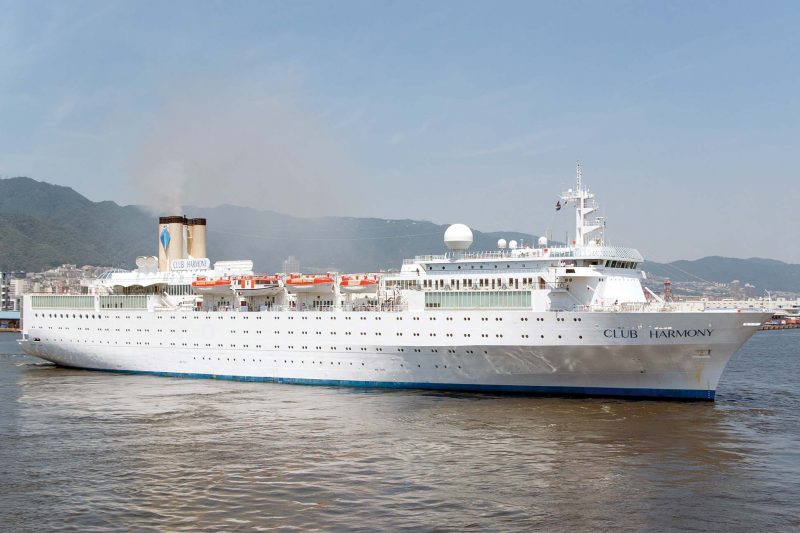
Postscript
I was fortunate to see both of these two unique cruises ships during their twenty year cruise careers at Mahon on Menorca while on holiday. They had cruised from the Costa Palocrociere terminal at Savona near Genoa, and were always fully booked, with almost the entire fleet of the island buses lined up on the quayside to take passengers on a tour of the island. The remainder of her passengers explored the delights of old Mahon town on foot, and while the vessels were awaiting their return, I was able to see the aft part of their public room decks through the three deck high wall of ‘plexiglass’ at their sterns. Although this view from the quayside was not ideal, an impression of the prodigious amount of glass used in their conversions could be gained. This plethora of ‘plexiglass’, coloured Murano glass and plate glass walls and dividers was hopefully recycled to new glass when both ships were scrapped.

Costa Marina and Costa Allegra were lovely cruise ships with a big, happy crew of four hundred Italian officers, stewards and the many other grades of cruise personnel. The decor of the interiors and the art installations were very definitely Italian, and for northern Europeans passengers, a knowledge of the ‘Romance’ languages of Italian, Spanish and French was essential, even though public tannoy announcements were in five languages. ‘The Ships of Glass’ were excellent and unique cruise ships, the like of which will never be seen again.
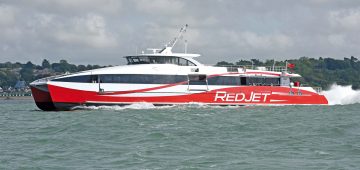



Comments
Sorry, comments are closed for this item